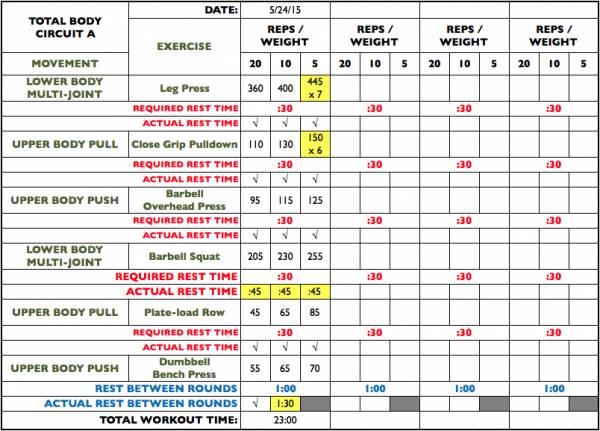Being physically fit can mean a number of things:
- Having the ability to run a marathon.
- Squatting or deadlifting for a set of ultra-high repetitions.
- Completing a triathlon or an obstacle course.
- Running a series of demanding intervals with minimal rest between.
- Completing a thirty-minute hard-core boot camp class.
All of these are great accomplishments and test your fitness levels. But is there another challenging test of strength and endurance you can add to your training? Yes, there is. It’s total-body circuit strength training.
These total-body circuits combine upper-body push/pull movements, lower body work, and core exercises.
A Brutal Test
Total-body circuit strength training can be brutal if done properly. It’s the ultimate simultaneous challenge of muscular strength and cardiovascular endurance. Your ability to exert maximum muscle effort for an extended period with the entire body is put to the test. All-out effort, minimal rest, and an elevated heart rate are key.
Why isn’t this a more popular training method? Because it’s extremely difficult and it’s not fun. Most trainees want to work hard, but not that hard. It’s human nature to seek the path of least resistance (no pun intended).
But if you decide to give total-body circuit strength training a try, know that it’s not complicated to design a circuit based on your ability:
First, determine an order of conventional strength training exercise movements. Some examples:
- Alternate upper-body push and pull exercises, then address the lower body.
- Alternate a series of lower body, upper-body pull, and upper-body push exercises.
- Alternate an upper-body pull, abdominal, lower body, upper-body push, and a bodyweight exercise for a certain number of rounds.
Next, determine the specific exercises. Incorporate variety. Use barbell, dumbbell, kettlebell, machine, and bodyweight exercises. You have a virtually unlimited number of exercise combinations to plug in.
Once your format is in place, determine exercise prescriptions. This would include the amount of resistance to use in each set, the target reps or work period time, the rest between exercises, and the rest between rounds if you’re doing a series of repeats. Many options can be used depending on your fitness level.
Keep the following in mind, all other factors being equal:
- The greater the number of exercises performed, the more challenging the circuit.
- The greater the intensity of effort expended, the more challenging the circuit.
- The lesser the rest time between exercises and rounds, the more challenging the circuit.
Finally, have some way to document your results. Record the exercises and resistances used, actual reps achieved, rest between exercises, and total workout time. This will help you progress when you revisit that same circuit in the future.

Record the exercises and resistances used, actual reps achieved, rest between exercises, and total time.
The Breakdown
Putting that all together, here is a breakdown of a sample circuit design. It’s a six-exercise, alternating multi-joint lower body, upper-body pull, upper-body push format performed for three rounds of descending reps:
3 rounds – 20, 10, and then 5 reps:
- Leg press
- Close grip pulldown
- Standing dumbbell press
- Barbell squat
- Plate-load row
- Barbell bench press
Rest :30 between exercises and 1 minute between rounds.
After you go through all six exercises performing twenty reps on each, then repeat the list again for ten reps, and then five, using the same prescribed rest periods. Adjust the resistance used for each set according to your fitness level.
Here is an example of the results documented for this circuit:

Other Possible Combinations
Here are other multi-joint lower body, upper-body pull, and upper-body push exercise combos you could use in this 20-10-5 circuit format:
- Goblet squat
- Close grip pulldown
- Dips
- Leg press
- Upright row
- Overhead press
- Machine squat
- Dumbbell one-arm row
- Barbell bench press
- Dumbbell lunge
- Low pulley row
- Seated dumbbell press
- Barbell squat
- Assisted chin up
- Machine chest press
- Dumbbell deadlift
- Close grip pulldown
- Barbell standing press
Click here to download a workout form and record your results.

If you can complete these circuits exactly as outlined, then you’re in very good condition.
Key Points to Remember
Key points in completing this three-round total-body circuit:
- It should be demanding to get the 20, 10, and 5 repetitions prescribed.
- Try to rest exactly :30 between exercises. If you need more time, record the time on the attached form.
- Try to rest no more than 1 minute between rounds. Again, if you need more time, document it on the recording form.
- Adjust the resistance to make each set demanding. Increase or decrease the resistance accordingly for the next workout if it was either too light or too heavy for the prescribed reps.
Another Option
Here’s another total-body circuit strength training workout. It consists of two intervals, a lower-body multi-joint exercise, and then four alternating upper-body push and pull exercises.
4 rounds of :40/:20
- Heavy bag punching and kicking
- Stairclimber, elliptical, rower, or take your pick
- Lower-body multi-joint
- Upper-body chest push
- Upper-body pulldown
- Upper-body overhead push
- Upper-body low row
That’s :40 of all-out effort for each exercise and only a :20 rest between exercises and rounds. Essentially, it’s an attack on the entire body via 28 exercise bouts (seven exercises times four rounds).
Attempt to use a resistance that allows dynamic reps to be completed in the entire work period for the five conventional strength-training movements. If you fail dynamically during the period keep pressing or pulling through a shorter range of motion or statically until the time elapses. The key is to keep contracting muscle as hard as you can. For safety reasons, use a training partner to assist you when your muscles fail concentrically.
Stick to the :20 rest period, including between rounds.
Here is an example of exercises you can use in this circuit:
- Heavy bag
- Arc Trainer
- Trap bar deadlift
- Machine chest press
- Wide grip pulldown
- Barbell seated press
- Low pulley seated row
Adjust resistances accordingly. If you cannot adhere to the rest periods, then take additional time but document it along with the resistances used.

This circuit is an attack on the entire body via 28 exercise bouts (seven exercises times four rounds).
Take the Total-Body Test
These are two examples of how you can design total-body circuit strength training workouts. If you believe you’re in great shape, put yourself through one and see if you can complete it as prescribed.
If you can complete these circuits exactly as outlined, then you’re in very good condition. Want to do more? Go ahead and do it if you’re in tip-top shape.
More Like This:
- The Incremental (But Intense) Circuit Workout
- Super Circuit Strength and Conditioning for Mature Athletes
- The 6×6 Brutality Workout
- New on Breaking Muscle Today
Photos courtesy of Shutterstock.






